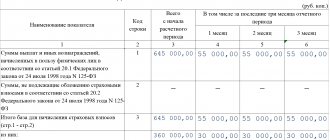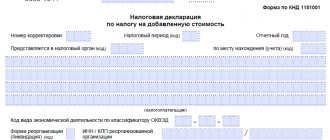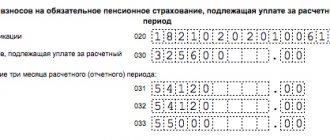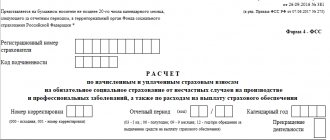Procedure for collecting insurance premiums
The insurance system for citizens in case of temporary disability is represented in our country by the Social Insurance Fund. Every employer with employees must pay contributions to the fund. If an entrepreneur or organization has at least 1 employee, the company is considered the citizen’s insurer in case of illness, injury, occupational disease or maternity leave.
What is the essence of the social insurance system? If an employee is sick, injured, or an employee becomes pregnant, then they cannot work during illness or maternity leave. The state has provided a procedure for financial support for such citizens, obliging employers to pay insurance contributions from employees’ wages. This money goes to the Social Insurance Fund and is then not only distributed among sick people, those injured at work and women on maternity leave, but also goes to finance measures to protect labor and ensure safety in the workplace.
The employer pays 2 social security contributions:
- In case of temporary disability and in connection with maternity. The contribution rate is set in the range from 0 to 2.9% of wages (depending on the company’s activities and available benefits).
- From industrial accidents and occupational diseases. The contribution amount is from 0.2 to 8.5%. It depends on the degree of injury in the main type of activity at the enterprise.
Important! Even if your company is on the list of beneficiaries and does not pay contributions in case of temporary disability (for example, a simplified individual entrepreneur producing food), then you, as an employee, still have the right to pay for sick leave and parental leave.
Contributions are transferred to the fund monthly from the wages of each employee and are included in the costs of the enterprise. Merchants using the simplified tax system “income minus expenses” can accept the amount of paid contributions as expenses, and on imputation and the simplified tax system “income” they can partially reduce the tax payable.
The employee has the right to count on average earnings during the period of incapacity, but the final amount of the benefit depends on his length of service.
Note! In some cases, other rules for paying average earnings apply. For example, if an employee’s illness or injury was the result of intoxication, then the amount of benefits is limited to the minimum wage, regardless of the guard.
Unpaid benefits
The employer is obliged to provide sickness, maternity and child care benefits within 10 calendar days from the date of the employee’s application. And the assigned benefits must be paid along with the next salary. This is the requirement of Article 15 of Federal Law dated December 29, 2006 No. 255-FZ. However, this is not always the case. It happens that the employer delays the payment of benefits (for various reasons). So, starting from the reporting for the first quarter of 2015, assigned but not paid benefits should be shown in the reporting, namely:
- in line 16 of Table 2 you need to reflect unpaid disability and maternity benefits;
- in line 11 of Table 8 you need to reflect unpaid benefits from accidents and occupational diseases.
It is obvious that the FSS will not reimburse these benefits to employers.
Reporting on insurance premiums: form 4-FSS
Insurers must report information on calculated and paid social insurance contributions, as well as sick leave, maternity, and child care benefits to the Social Insurance Fund. To do this, fill out form 4-FSS . It is required to be submitted by all employers making payments to employees.
The title page of form 4-FSS , tables 1, 3, 6, 7 and 10 are always filled out, the remaining tables depend on the type of activity of the company, the category of insured persons and other criteria.
On the title page the company states:
- your data;
- reporting period;
- number of employees.
If the company submits a report for the first time during the reporting period, then in the “Adjustment number” field you need to indicate 000. When submitting updated calculations, the field is filled in in accordance with the number in order of the adjustment report: 001, 002, etc.
Note! If you are applying for a refund, then in the “Reporting period” field you need to fill out the last 2 cells, writing in them the serial number of the application to social security from the beginning of the calendar year. That is, if you reimburse paid benefits for the 2nd time in a year, you need to indicate 02.
Let us briefly indicate what information is reflected in each of the tables:
- Table 1 of the 4-FSS includes information about the company's debt in contributions, the amount of contributions payable for the period, additionally accrued contributions, fund funds allocated to pay benefits, the fund's debt to the company, the amount of benefits paid and the amount of contributions paid to the fund.
- Table 2 provides a breakdown of the firm's benefit costs. Social benefits are divided by type: sick leave;
- maternity leave;
- child care benefits;
- benefits for the birth of a child and registration in the early stages of pregnancy, etc.
The accountant must indicate in the appropriate lines the number of days or benefits paid. Expenses are transferred on an accrual basis from the beginning of the billing period. The amounts of accrued but not paid benefits are also indicated.
- Table 3 contains information about the basis for calculating contributions. In this case, the amounts of payments that are not subject to contributions are entered in a separate line.
- Table 6 contains information on the base for calculating contributions for insurance against accidents and occupational diseases and the size of the insurance tariff.
- Table 7 is intended for information on accrued and paid contributions for occupational diseases.
- Tables 8 and 9 are filled out by firms that had work-related injuries or took measures to prevent injuries during the reporting period.
- Table 10 is intended to transmit to the fund information about conducting a special assessment of working conditions and medical examinations of workers.
more detail about how to fill out form 4-FSS in different situations.
Note! Participants in the project to reform the procedure for transferring benefits have their own rules for filling out form 4-FSS.
Temporary foreign workers: reflection of contributions and benefits
From January 1, 2015, temporarily staying foreigners are considered insured under compulsory social insurance in case of temporary disability and in connection with maternity. And they have the right to apply for temporary disability benefits, provided that the employer paid insurance premiums for them for at least 6 months preceding the month in which the insured event occurred (see “From 2015, it will be necessary to pay contributions to the Social Insurance Fund for foreigners and temporarily workers staying in Russia"). The rate of insurance contributions to the Social Insurance Fund for payments to temporarily staying is 1.8% (Part 3 of Article 58.2 of Law No. 212-FZ). These innovations are reflected in the 4-FSS calculation form.
Table 2: reflection of benefits
Benefits paid to temporarily staying foreigners will need to be shown in line 3 of Table 2. However, keep in mind that there will be nothing to show for the first quarter of 2015, since in order to receive benefits, we repeat, contributions must be paid for at least 6 months. Therefore, even if we assume that a temporarily arrived foreigner has been working since January 1, 2015, he will be able to receive benefits no earlier than July 2015.
Do I need to submit empty 4-FSS tables?
- the title page, tables 1 3, 6, 7, and 10 are mandatory for submission by all policyholders;
- if there are no indicators for filling out tables 2, 3.1, 4, 4.1, 4.2, 4.3, 5, 8, 9, these tables are not filled out and not submitted (clause 2 of the procedure for filling out 4-FSS).
Table 3: calculation of the base for calculating contributions
Line 8 of Table 3 will now need to show payments to temporarily staying foreigners. At the same time, we note that in the title of this line a reservation is made that payments in favor of temporarily staying foreigners from Belarus, Kazakhstan and Armenia are not included in line 8. Therefore, they will need to be shown not in this row, but in row 1 of the table (that is, together with Russian employees). For more details, see “Workers from Belarus, Kazakhstan and Armenia: how to calculate insurance premiums, benefits and personal income tax for them in 2015.”
Table 3.1: information about foreign workers
Table 3.1 appeared in the calculation, into which data on temporarily staying foreigners should be entered: full name, tax identification number, SNILS and citizenship. Moreover, this table must be filled out without reference to the payment of benefits to them. That is, if in the first quarter of 2015 the organization has such employees, then the table needs to be filled out. However, workers from Belarus, Kazakhstan and Armenia do not need to be included in the table. This is directly stated in paragraph 11 of the procedure for filling out 4-FSS.
Payment of benefits directly from social insurance: nuances of filling out form 4-FSS
Reform of the social insurance system began in 2011. The current procedure (payment of benefits first by the employer, and then offset of the paid amounts against insurance contributions to the fund or reimbursement of overexpenditures) officials proposed to replace the payment of benefits to insured persons directly from the funds of the territorial branches of the Social Insurance Fund.
The direct benefit project was launched in July 2011:
- the first signs were the Karachay-Cherkess Republic and the Nizhny Novgorod region;
- in 2012, they were joined by the Khabarovsk Territory, Astrakhan, Kurgan, Novgorod, Novosibirsk and Tambov regions;
- in 2015 - the Republic of Crimea and Tatarstan, the federal city of Sevastopol, Belgorod, Rostov and Samara regions;
- in the summer of 2021, the Republic of Mordovia, Bryansk, Kaliningrad, Kaluga, Lipetsk and Ulyanovsk regions should join.
The full transition to direct payment of benefits is scheduled for 2017.
What will change with the introduction of the new system for employers and employees:
- This will simplify the work of policyholders, since the fund itself will calculate the amount of payment based on data on earnings and length of service. This data will continue to be provided by the policyholder. Disputes with the Social Insurance Fund about the legality of calculating benefits and their amounts will become a thing of the past.
- For employees, the new payment procedure means guaranteed correct transfer of sick leave and other benefits, as well as the choice of how to receive money - to a bank account or by postal transfer.
The mechanism for issuing a certificate of incapacity for work remains the same:
- the employee brings sick leave to work;
- the accounting department enters it into the electronic register within 5 days and transfers it to social insurance;
- the fund pays money to the insured person within 10 days from the date of receipt of the document.
In the future, a universal database of sick leave certificates throughout the country should help combat violations in the social insurance system, for example, the purchase of sick leave.
Already now, the above regions fill out form 4-FSS according to special rules - in accordance with Decree of the Government of the Russian Federation dated April 21, 2011 No. 294 and Order of the Federal Social Insurance Fund of the Russian Federation dated June 23, 2015 No. 267. Such insurers bear the cost of paying only for the first 3 days of the employee’s illness. They do not fill out Tables 2 and 5 of Section I of Form 4-FSS Table 8 of Section II and line 15 of Table 1 of Section I also remain empty.
Section I, Table 1
OKVED code - indicated on the basis of an information letter with state statistics codes.
In the columns “Debt owed by the policyholder at the beginning of the billing period (1)” and “Debt owed to the territorial body of the Fund at the beginning of the billing period (12)”, the figures are indicated at the beginning of the reporting year 2013 (these same indicators were reflected as of December 31, 2012 in the reporting for year 2012).







